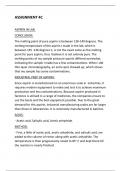Other
Unit4C Laboratory techniques and application
- Institution
- PEARSON (PEARSON)
This is the third assignment for unit 4, applied science (the new specification). I got a distinction for this assignment, It explains the method of making aspirin and purifying it.(plagiarism-free). Please message me if you have any doubts- happy to help!
[Show more]



